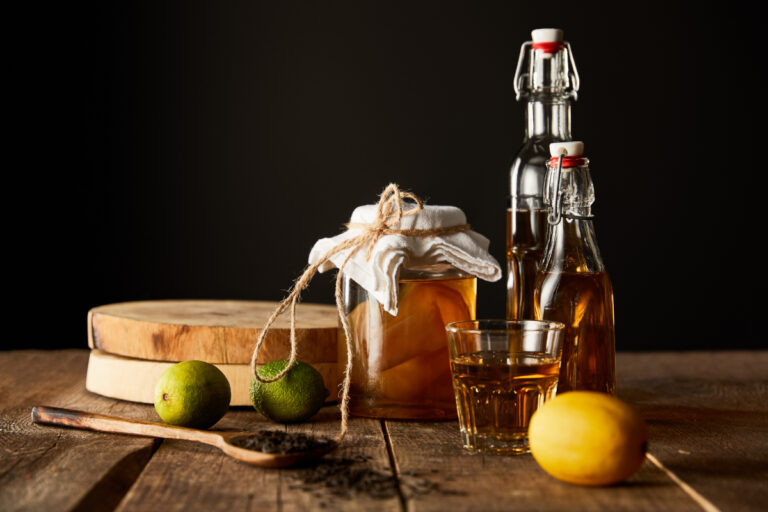A recent report by Graphical Research indicates that there has been a growing demand for kombucha each year and states that the kombucha market will likely reach revenues of approximately two billion dollars by the year 2026.
But what exactly attracts people to such an exotic beverage? After all, the drink is known to contain compounds which can be reminiscent in taste to vinegar. The flavor certainly doesn’t “click” with everyone, and kombucha can be quite expensive in comparison to other beverages. It does, however, offer a unique experience unlike anything else on the market and many people do seem to love the acidic flavor of this traditional fermented tea.
There are already many articles on the internet regarding the purported health benefits of kombucha, so I thought today we would discuss the often unconsidered history and globalization of this fabled drink.
Table of Contents
What is Kombucha Tea?
Kombucha is a sweetened and fermented tea product. The basic ingredients are black tea, sugar, and yeast, but modern renditions often contain numerous other ingredients as well, such as juice or natural herbs, in order to enhance or alter the flavor profile.
The drink is slightly effervescent and and has a unique fizziness which seems to appeal to adventurous consumers.
Although a popular brand of kombucha was once named the most liberal product in America in Slate Magazine, kombucha is of Chinese origin and and has simply been well-marketed in North America.
We’ll discuss the history and globalization of kombucha tea in the next sections.
The Origin of Kombucha
Kombucha has a somewhat murky history.
Kombucha was almost certainly invented in China, as it is mentioned in Chinese documents dating back to the Qin Dynasty during approximately 221 BC and as a tea-based product, it would also make a lot of sense. Unfortunately, due to these events taking place such a long time ago, it is hard to say for certain.
“The most famous legend of Kombucha’s origin dates it to the Qin dynasty (221-206 BCE) during which time … it was referred to as the “Tea of Immortality.” The emperor Qin Shi Huang (秦始皇) is said to have sought to lengthen his life by any means available and this Tea of Immortality was delivered by alchemists at his request.” – The Big Book of Kombucha
Many scholars believe it was first created in the Bohai Sea district of China, but the exact location is unknown.
It is fairly likely that kombucha was invented by accident, as the fermentation process was not fully understood during that time period. The “scoby”, which is short for “Symbiotic Colony of Bacteria and Yeast”, is a pancake-like mass of bacteria commonly used to initiate the kombucha fermentation process was often passed on and used as long as possible, as they did not fully understand the science behind it.
The beverage was historically praised for it’s purported healing properties and is known to contain a considerable amount of probiotics and potentially beneficial compounds, but more research is needed for clarification.
The Globalization of Kombucha
Kombucha was eventually sold along the ancient Silk Road trade route, inevitably winding up in Russia where it became quite popular. From there, it was exported to Europe and its surrounding regions.
It is now brewed all throughout the world, including regions such as China, Russia, Europe, Korea and the United States of America, although kombucha wasn’t really a popular a popular beverage in the United States until fairly recently, in the 21st century.
Nowadays you can find kombucha available for sale just about everywhere.

